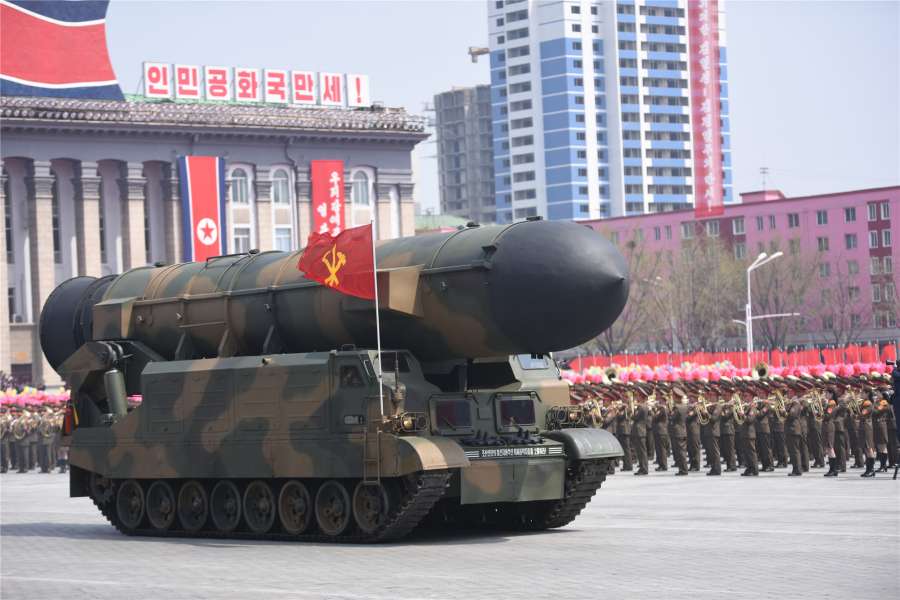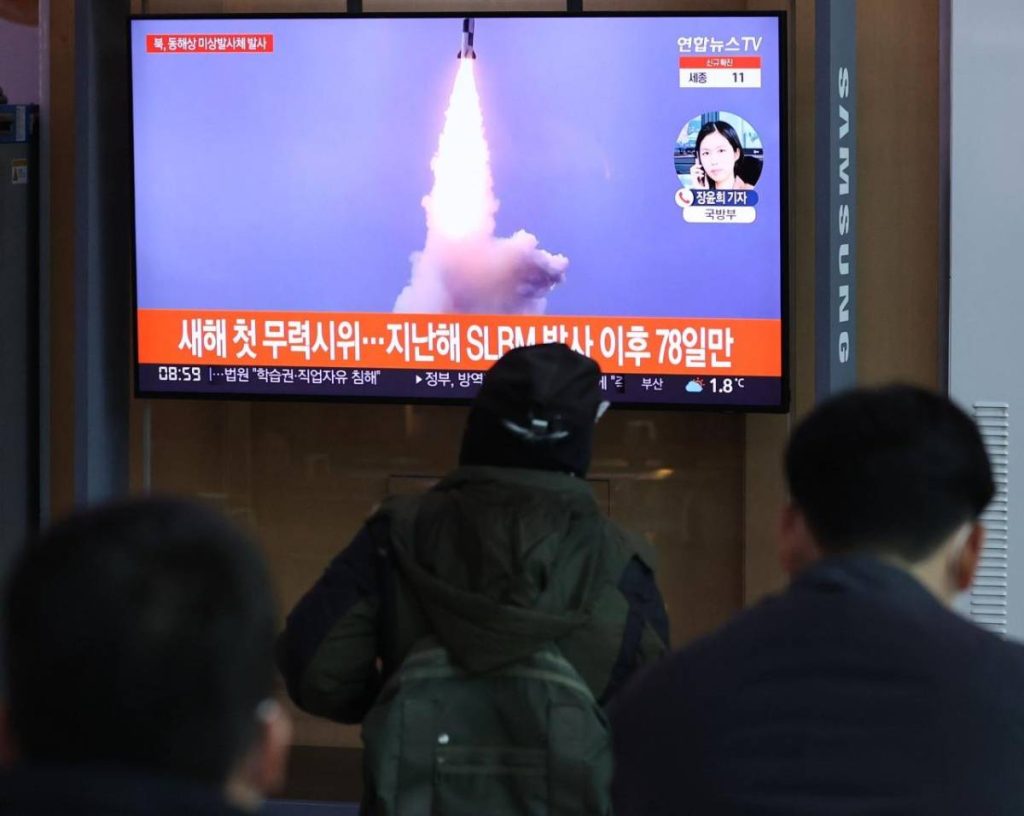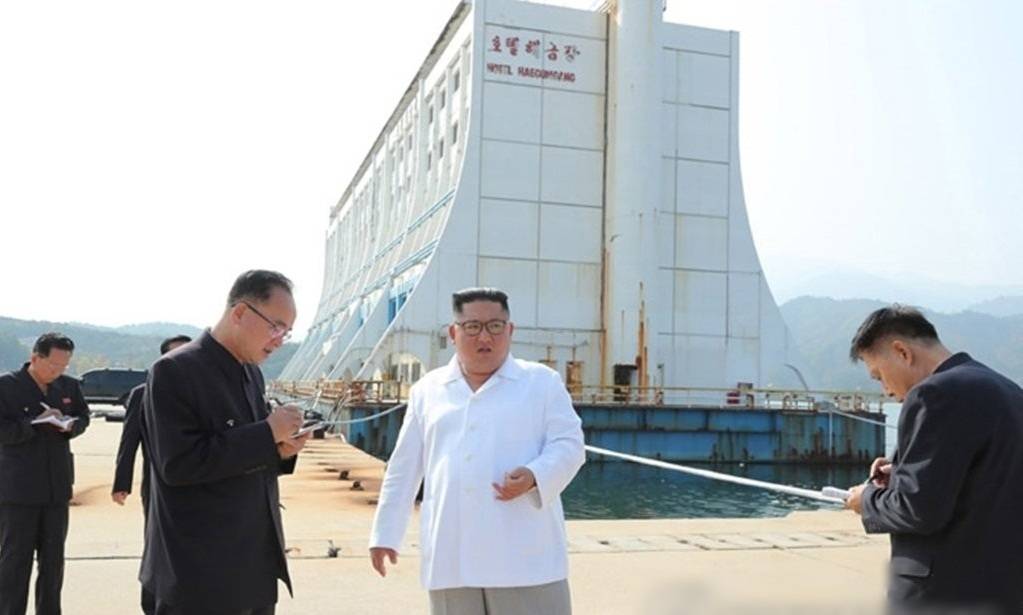Given the low probability of high-level negotiations between Washington and Pyongyang soon taking place, those in the first circle of power around Supreme Commander Kim, who favour a nuclear test, appear to be prevailing, writes Prof. Madhav Nalapat

Speculation is rising in key capitals that the Democratic People’s Republic of Korea (DPRK) is on the verge of testing a newly developed thermonuclear device. Authorities there believe that a fresh nuclear test would be advantageous in view of the impasse being faced with an unresponsive Biden administration. There has been an absence of any forward movement by President Biden on talks with the DPRK aimed at reducing tensions in the Korean peninsula.
Meanwhile, there is no progress on removal of the US sanctions imposed over the years on the DPRK. Such stasis has confirmed the view of hawks in Pyongyang that what is actually sought by the US-Japan alliance is the downfall of the Kim dynasty that has ruled the country since its founding in 1948. After such a change at the top, the calculation that is believed to have been made in Tokyo and Washington is that a new leader of North Korea would (as a consequence of the aftershocks of the fall of the Kim dynasty) be amenable to the elimination of the nuclear program, unlike the stand taken by the Kim family.
Given that North Korea is considered to have built up nuclear weapons and delivery capability sufficient to obliterate US bases in Japan, Guam and Hawaii, it is seen in Pyongyang as axiomatic that the Biden administration would not go to war as a consequence of resumed nuclear testing. As for sanctions, the calculation is that a demonstration of enhanced DPRK nuclear capability would increase rather than reduce prospects of US-DPRK talks to lower the rise in tensions caused by a resumption of testing.
A fresh test, in Pyongyang’s view, as conveyed by sources spoken to, would highlight the “wrongness of believing that sanctions can shake the iron resolve of Supreme Commander (Kim Jong Un) to ensure security” for the DPRK through nuclear capability. Another nuclear test (of a more advanced device) would, in the thinking within the first circle of power in Pyongyang, be a reality check to the “daydream ers and evil schemers who believe that they can scare into submission the Supreme Commander (Kim Jong Un) by threats of war or more sanctions”.
FUNCTIONAL ICBM LAUNCHED
These sources point to the numerous personality traits that Kim Jong Un shares with his grandfather Kim Il Sung, who founded the dynasty that has thus far ruled North Korea. Judging by his invasion of the South, it is evident that Kim Il Sung was a risk taker who had immense confidence in the resilience and capabilities of both himself and the people he led. Interestingly, several in the Korean peninsula believe that a part of the DNA of the Korean people originated in India courtesy a Royal Princess and her retinue, who is said to have moved to Korea millennia ago.
he noble ladies who accompanied the princess from India (who was probably from a coastal area) are said to have married into the Korean aristocracy of the time. Having waited more than a year for Washington under the Biden administration to enter into “realistic and equal” negotiations with Pyongyang, nuclear restraint in that capital seems to be on the way out. This is especially so after numerous missile launches have failed to persuade the White House to restart talks, including on the subject of sanctions. Of significance is the claim that the DPRK (according to the sources spoken to) appears to have made a breakthrough in the type of nuclear device that the country is capable of producing and deploying.
What appears to be a functional ICBM has been test launched since Joe Biden became the 46th President of the US. Now “all that remains is to show that the rocket can be armed with a nuclear device of sufficient destructive capability to deter even thoughts of attack” in the minds of either Japanese or US leaders. What has generated considerable “anger and doubt” in the first circle of policy in Pyongyang, which includes the “fiercely loyal, patriotic and capable” sister of the Supreme Commander, Kim Yo-jong.
Suspicion about US intentions aimed at regime change has been reinforced by the refusal of the White House to have permitted a peace treaty between the DPRK and the RoC, despite the former President of the RoC favouring such a move. His successor Yoon Seok-youl has walked away from his predecessor’s accommodative stance and aligned himself fully with the Washington-Tokyo hard line on North Korea.

KINETIC WINDOW HAS SHUT
Kim Jong Un has been going ahead at accelerating speed despite US-led sanctions with the DPRK’s nuclear and missile development. Evidence of the capability and resilience of the Korean people as a whole is present in the spectacular economic success of the southern part of the peninsula, the Republic of Korea (RoC). Given the nature of the Kim regime, acquiring accurate information about its inner workings is problematic, but sources known in the past to be accurate claim that the only window for ending the DPRK’s nuclear and missile program voluntarily was during the period when Kim Jong Il was in charge of the DPRK after the passing of his father Kim Il Sung in 1994.
The problem was, according to the sources communicated with, that the Clinton administration negotiators were insistent on North Korea completing the decommissioning of its nuclear and missile program before the US went ahead with significant sanctions relief. The sanctions relief offered in advance of complete fulfillment of US demands were merely cosmetic, high on symbolism but low on substance. The excuse trotted out by Clinton era negotiators was that it was “politically impossible” for President Clinton to give more upfront relief to the DPRK, as there would be adverse opinion even within the Democratic Party at any such substantive concession.
Whatever the reasons, the best (non-kinetic) chance available for the denuclearisation of North Korea was passed up during the period of the Clinton administration. As for seeking denuclearisation through kinetic means, by the time Barack Obama stepped down as President of the US in 2017, advances in nuclear and missile systems by the DPRK made what was an improbable into an impossible option.
SIMILAR POLICY THREAD ACROSS ADMINISTRATIONS
Even during the Trump presidency, sources aver that DPRK Supreme Commander Kim Jong Il knew “from the start” that he was being asked to carry out “irreversible actions in exchange for just promises of relief” by the US. Steps that could swiftly be reversed once the DPRK had carried out its part of such a (in the view of the first circle in Pyongyang) one-sided bargain. According to these sources, some of the comments being made by “influential theoreticians” in Tokyo and Washington during the Trump-era DPRK-US negotiations made it very likely that such a snapback of US concessions would take place once the DPRK trustingly delivered, on some “silly pretext”.
The George W. Bush presidency was regarded by the other side as a period of intensified efforts at “forcing rather than persuading” the other side to make irreversible commitments in exchange for cosmetic concessions by the US. Such a zig (of progress in talks being followed by the zag of reversal of gains) continued during the Obama period. It seemed as though the 44th President of the US had left the matter to his staff rather than get personally invested in securing a binding agreement in the manner President Trump later was. The consequence was that the Obama staffers who were engaged in negotiations substantively followed the Clinton-Bush line, offering only “small steps forward in exchange for big steps backward (from the nuclear and missile program)” by the DPRK.
During the Trump presidency, the perception on the other side was that the US President was never on the same page as key staff members, “many of whom wore scornful expressions on their faces (even while President Trump was speaking)”. The difference in “mood and tone” between President Trump and his key associates that was tracked by the other side strengthened the impression that President Trump was not politically or administratively truly in charge, and was “not strong enough to carry out any of the promises that he brought to the discussions in the manner of flower petals”.

A CONFIDENT KIM JONG UN
Once Kim Jong Un took charge in 2011, the window of opportunity available during the period in office of his predecessor Kim Jong Il for any voluntary reversal of the DPRK nuclear weapons program effectively closed. The new Supreme Commander of North Korea, from the start, was clear that the DPRK “needed to be treated as an equal of the US”. This included at least tacit acceptance of its nuclear status. In the view of the North Korean leadership, a credible nuclear deterrent was an indispensable component of regime security for the Kim dynasty.
The Korean nation, “once unified, must be a nuclear weapons power for the world to show it respect” was the view of the inner ring of the North Korean leadership, according to the sources accessed. In the meantime, what was in effect on offer by Pyongyang was a non-aggression pact between the US plus allies and the DPRK, in which neither side would mobilise (much less use) conventional or non-conventional (as distinct from asymmetric) weapons against the other. The Trump-Kim talks were, therefore, a non-starter ab initio, given the perceived inability of President Trump to ensure compliance from his staff to action any up-front concessions as evidence of US good faith where matters of regime security in the DPRK were concerned.
AUTHORITARIAN MODEL ADOPTED
The founder of the dynasty, Kim Il Sung, is held to have sought to restore his country to what he regarded as its former glory. The cloak of communist doctrine was a means towards that, in that such a system favoured the authoritarian control that the Founder regarded as essential to steer a unified peninsula of the “noble Korean people” towards greatness. In contrast, democracies were seen as “unstable and chaotic”, terms that CCP General Secretary Xi Jinping clearly concurs with. Reports reaching Pyongyang of “political and administrative conflicts, confusion and turmoil” in matters of policy and governance in the US during the Obama and Trump periods reinforced such a view.
Such a situation was a contrast to the swift assertion of authority in China by Chairman Mao Zedong once the CCP took over China in 1949. The founder of the Kim dynasty, Kim Il Sung, sought from the start to unify the peninsula by force of arms. According to the sources accessed, Kim Il Sung, believed that the US would keep aloof from the conflict that he launched against South Korea in 1950. Kim believed that US non-involvement would be the consequence of not wanting to tangle militarily with the USSR in Asia at a time when Washington was already facing headwinds from Moscow in Europe.
To Kim’s surprise, despite advance warning being given to CPSU General Secretary Marshal Stalin about the impending attack, Soviet forces remained concentrated in Europe. It was thereby made clear to all sides that the USSR would not intervene militarily should there be a war between the DPRK and the US in the Korean peninsula. The North Korean side was convinced that prior knowledge of Soviet forbearance in the matter of entering the Korean war militarily was crucial in President Harry S. Truman’s decision to intervene after DPRK forces overwhelmed the defences of the RoC.
The initial successes of US forces were leading to the unification of Korea, but under the RoC and not the DPRK. This was when General Douglas MacArthur disregarded the warning given by PRC Premier Zhou Enlai through Indian diplomats that the PLA would enter the war, should US troops move to the Yalu (Amarok) river. The entry of the PLA into the conflict was ordered by Mao Zedong, who, according to those in Beijing familiar with the thinking of the “Great Helmsman”, was of the view that General Douglas MacArthur would press on past the Yalu into the PRC in order to create a base from which US and KMT forces would seek to wrest back China from the control of the CCP.
Some of the statements made by General MacArthur in the initial process of operations in Korea are seen as not contradicting but reinforcing this view in Zhongnanhai. In contrast to his father, Kim Jong Il was not expansionist, and was therefore more cautious. In contrast, his son Kim Jong Un has, according to the sources accessed, “treasured in his mind” the objective of Kim Il Sung for a unified Korea. The present leader of North Korea has set a far more ambitious goal for himself than simply his father’s focus on regime survival. Following the path of not his father but his grandfather, Kim Jong Un wants to unify the Korean peninsula under his leadership.
Kim Jong Un has, according to the sources accessed, less than full confidence that CCP General Secretary Xi Jinping, unlike Chairman Mao, would intervene militarily to assist the DPRK in the event of a kinetic conflict between North Korea and the US-Japan alliance. The 2022 Ukraine war has strengthened Kim Jong Un’s belief that only the acquisition of capability to reach both coasts of the continental US with nuclear weapons is sufficient to deter the White House from sending another MacArthur to Korea to expand what (policymakers in Pyongyang believe) is already a comprehensive thus far non-kinetic war by the US-Japan alliance against the DPRK.
The insistence by Washington of “irreversible steps” to DPRK nuclear disarmament even to get “symbolic and cosmetic” concessions is seen in the North Korean capital as proof that the Biden administration is following the same playbook used by Presidents George W. Bush and Barack Obama against Saddam Hussein and Muammar Gaddafi (and later attempted with unsuccessfully against Bashar Assad). This is to “ensure the destruction of the offensive capabilities of the adversary through negotiations before attacking it in a fatal blow” against a now “defenceless foe”.

REGIME CHANGE AS PRIMARY U.S. OBJECTIVE
While President Donald J. Trump was attacked by political adversaries as having conceded much for little simply by agreeing to meet Kim Jong Un, the DPRK side was disappointed that throughout “it was the Bolton line that was being pushed” behind (in their view powerless) “President Trump and his friendly face”. Then National Security Advisor (NSA) John Bolton was clear that a “Libyan solution” was what was needed in North Korea. This revived memories in the first circle of the final moments of Muammar Gaddafi, images of which have been watched over and over again in Pyongyang, including the glee in Secretary of State Hillary Clinton’s expression at the savage manner in which the Libyan dictator was executed.
There was no desire in Pyongyang to watch similar expressions appear on the faces of US officials once their objective of ensuring a “Libyan solution” was achieved by the US under the cover of President Trump’s show of friendship. Simply put, the conclusion reached after the failure of President Trump’s doomed mission to charm “Rocket Man” into handing over his nuke capabilities to the US was that only the North Korean nuclear deterrent was preventing the “Pentagon and CIA” from attempting regime change through war against the DPRK in the manner carried out in Iraq, Afghanistan and Libya and attempted in Syria.
And of what use is a deterrent unless its potency is demonstrated in public? The view in the first circle of leadership, according to the sources accessed, is that “the low level” (of US) officials attempting negotiations under President Biden indicates the “lack of seriousness to remove the poison that has been injected (by previous administrations)”.

HAWKS ASCENDANT IN PYONGYANG
Given the low probability of high-level negotiations between Washington and Pyongyang soon taking place, those in the first circle of power around Supreme Commander Kim who favour a nuclear test appear to be prevailing in the ongoing argument over whether the nuclear device newly developed by the DPRK should be tested soon or not. If Kim Jong Un accepts such a view, the test by the DPRK of a thermonuclear device will take place before long.
Once that happens, even to the hardline new administration in Seoul, the view on the other side of the 38th parallel is that it would become clear that policies based on going along with US-Japan efforts at regime change in Pyongyang would only lead to “unbearable rise in tensions and a cloud of crisis and uncertainty” that would affect economic prospects in South Korea severely. For those in Washington, Tokyo and perhaps Seoul who are eager to punish the people of North Korea by harsher sanctions for the decisions of their unelected government, it may be pointed out that sanctions have not worked in stopping the nuclear and missile programmes of the DPRK.
Neither, halfway across the world, have they succeeded in deterring Russian President Vladimir Putin from taking control of more and more territory in Ukraine, even as the disastrous effects across continents of the escalating Biden-Johnson sanctions on Russia push up global inflation and shortages, and bring Johnson and Biden closer towards a political meltdown.

